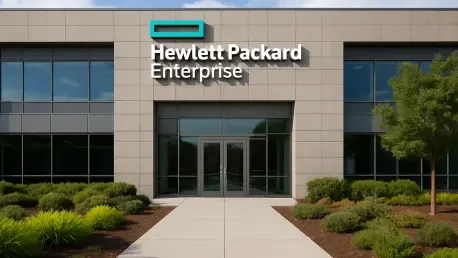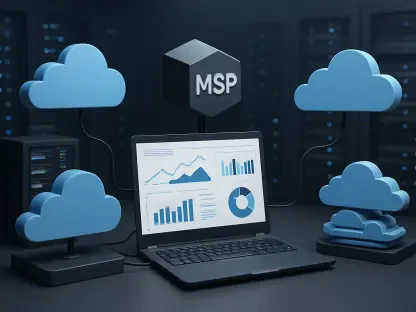Hewlett Packard Enterprise (HPE) stands at the forefront of a technological revolution, harnessing the explosive demand for artificial intelligence (AI) and cloud infrastructure to drive unprecedented growth, as evidenced by its fiscal third-quarter earnings report this year. The report paints a vivid picture of a business in transformation, achieving a striking 19% year-over-year revenue increase to $9.1 billion. This surge reflects HPE’s ability to tap into the AI boom, positioning it as a formidable force in enterprise computing. However, beneath the surface of these impressive figures lies a complex narrative of balancing rapid expansion with profitability in a highly competitive landscape. The stakes are high as HPE navigates this dynamic environment, where strategic decisions today will shape its trajectory for years to come. From blockbuster acquisitions to innovative partnerships, the company’s moves are both ambitious and fraught with challenges that demand careful execution.
Financial Performance and Growth Drivers
Revenue Surge and Segment Highlights
HPE’s financial results for the third quarter reveal a robust growth story that underscores its strategic focus on high-demand areas. The company reported a record-breaking $4.9 billion in revenue from its Server segment, a 16% increase compared to the previous year, driven by the launch of the ProLiant Gen 12 platform and soaring enterprise interest in AI infrastructure. This achievement highlights how HPE is capitalizing on the urgent need for powerful computing solutions to support data-intensive workloads. Beyond servers, the Networking segment saw an even more dramatic rise, with revenue jumping 54% to $1.7 billion. Much of this success stems from the recent integration of Juniper Networks, which has significantly enhanced HPE’s capabilities in AI-native networking. These figures not only reflect strong market demand but also validate HPE’s targeted investments in key growth areas that are reshaping the tech industry.
Delving deeper into the revenue drivers, the impact of strategic acquisitions becomes evident as a cornerstone of HPE’s financial performance. The integration of Juniper Networks, finalized earlier this year, has proven to be a catalyst for the Networking segment’s exceptional growth, providing advanced technologies like Mist AI and AI Load Balancing. Meanwhile, the Server segment’s success is tied to HPE’s ability to meet the escalating demands of enterprises building AI-driven systems, a trend that shows no signs of slowing. These segment-specific gains contributed to the overall revenue spike of 19%, positioning HPE as a leader in providing infrastructure for the digital economy. However, while the top-line numbers are impressive, they also set the stage for scrutiny over whether such growth can be sustained without sacrificing profitability, especially in a market where competition is fierce and pricing pressures are relentless.
Cash Flow and Financial Stability
Turning to broader financial health, HPE demonstrated a commitment to maintaining stability amid aggressive expansion. The company generated $719 million in free cash flow during the quarter, bolstered by effective inventory reductions and disciplined cost management. This cash flow strength offers a buffer against the heavy investments required for growth initiatives, providing reassurance to stakeholders about HPE’s fiscal responsibility. Additionally, the upward revision of full-year non-GAAP EPS guidance to a range of $1.88 to $1.92 signals management’s confidence in sustaining momentum. With a projected fourth-quarter revenue outlook of $9.7 to $10.1 billion, HPE appears poised to close the year on a strong note, reflecting optimism about continued demand for its solutions in AI and cloud infrastructure.
Beyond immediate cash flow metrics, HPE’s financial strategy reveals a careful balancing act between reinvestment and deleveraging. The robust free cash flow not only supports ongoing innovation but also aids in managing debt levels, with a long-term target of achieving a 2x net leverage ratio by fiscal 2027. This focus on financial discipline is critical as HPE navigates the costs associated with large-scale acquisitions and competitive market dynamics. Analysts note that maintaining such stability while pushing for market share in high-growth areas like AI servers and hybrid cloud solutions is no small feat. The raised guidance and optimistic revenue projections underscore a belief in HPE’s ability to execute its vision, though the path forward will require continued vigilance to ensure that growth does not come at the expense of long-term financial health.
Strategic Moves and Market Positioning
Acquisitions and Partnerships for Innovation
HPE’s strategic landscape is defined by bold moves that aim to cement its leadership in AI and cloud technologies. The $14 billion acquisition of Juniper Networks, completed in July this year, stands out as a transformative step, significantly enhancing HPE’s position in the $60 billion global networking market. This deal has introduced cutting-edge AI-native networking technologies, strengthening hybrid cloud offerings and positioning HPE to capitalize on a projected 27.73% compound annual growth rate in this segment through 2030. Alongside this, partnerships with industry leaders like NVIDIA have amplified HPE’s capabilities in delivering powerful AI infrastructure. The launch of HPE Private Cloud AI further demonstrates a forward-thinking approach to meeting enterprise needs for secure, scalable solutions in an increasingly data-driven world.
Complementing these acquisitions, HPE’s collaborative efforts signal a deep commitment to staying at the cutting edge of technology. Working with NVIDIA has enabled the company to integrate advanced GPU technologies into its server platforms, catering to the growing demand for AI workloads. The introduction of HPE Private Cloud AI represents a strategic pivot toward providing tailored solutions that address security and scalability concerns for businesses adopting AI at scale. These partnerships and product innovations are not merely tactical; they reflect a broader vision to redefine enterprise computing in an era dominated by data and automation. However, while these moves position HPE as a frontrunner, they also bring integration complexities and the need to continuously innovate to maintain a competitive edge against well-entrenched rivals in the tech space.
Industry Trends and Competitive Landscape
HPE’s trajectory aligns closely with the tech industry’s seismic shift toward AI and cloud-centric solutions, a trend reshaping how enterprises manage data-intensive workloads. By focusing on hybrid cloud and AI infrastructure, HPE taps into a critical need for scalable, secure systems that can handle the demands of modern business applications. This strategic alignment places HPE in direct competition with industry giants like Dell Technologies and Cisco Systems, particularly in the AI server and networking markets. The company’s emphasis on building robust infrastructure for AI applications mirrors a broader market push toward digital transformation, where speed and efficiency are paramount. Yet, standing out in this crowded field requires not just innovation but also the ability to deliver consistent value to customers amid evolving technological expectations.
Navigating the competitive landscape presents unique challenges for HPE as it seeks to differentiate itself. While the company has made significant strides with its hybrid cloud offerings and AI-focused solutions, the pressure to keep pace with rapid advancements is unrelenting. Competitors are equally aggressive in pursuing market share, often through price wars or faster innovation cycles, which can strain HPE’s resources. Analysts point out that maintaining a lead in this environment demands a sharp focus on research and development, alongside strategic pricing that balances profitability with accessibility. As the industry continues to evolve, HPE’s ability to adapt to emerging trends—such as the integration of AI into everyday business processes—will be crucial. The stakes are high, and the company must ensure that its market positioning remains robust against both current rivals and potential disruptors.
Challenges and Risks in Expansion
Profitability Pressures and Margin Concerns
As HPE pushes for growth, profitability pressures have emerged as a significant hurdle. The Networking segment saw its non-GAAP operating profit margin decline to 20.8% from 22.4% in the prior year, largely due to the lower-margin business model of the recently acquired Juniper Networks. Similarly, the Server segment experienced a sharp drop to 6.4% from 10.8%, reflecting competitive pricing pressures in the AI server market and the high upfront costs of scaling operations. These declines underscore the trade-offs HPE faces as it prioritizes market share over immediate financial returns. Management has acknowledged this strategic choice, emphasizing a long-term vision of dominance in key markets, even if it means weathering short-term margin compression that could unsettle investors looking for quicker profitability gains.
The implications of these margin challenges extend beyond quarterly reports, shaping perceptions of HPE’s financial strategy. The integration of Juniper Networks, while a boon for revenue, has introduced complexities in aligning business models with differing profit structures, adding to the strain on overall margins. Additionally, the AI server market’s competitive nature forces HPE to offer aggressive pricing to secure contracts, further squeezing returns in the short term. This dynamic creates a delicate balance where the company must invest heavily to maintain technological leadership while managing costs to avoid deeper financial strain. For stakeholders, this situation raises questions about how long HPE can sustain such sacrifices without seeing tangible improvements in profitability, especially as market dynamics continue to evolve rapidly.
Integration and Execution Risks
Beyond profitability, HPE faces substantial risks tied to the execution of its ambitious expansion plans. The integration of Juniper Networks, while strategically sound, carries the potential for delays or missteps that could disrupt operations and erode investor confidence. Achieving the projected $600 million in cost synergies over the next three years, with $200 million targeted in the first year, is a tall order that demands meticulous planning and flawless execution. Any hiccups in merging systems, cultures, or technologies could delay these savings, impacting financial projections and market perceptions. Such risks are not merely theoretical; they represent real challenges that could hinder HPE’s ability to fully realize the benefits of its transformative acquisition in a timely manner.
Further complicating the landscape are the broader execution risks associated with scaling in a competitive environment. HPE must navigate the integration process while simultaneously innovating to keep pace with rivals who are not standing still. The pressure to deliver on synergy targets is compounded by the need to maintain customer trust and operational stability during this transition period. Analysts caution that failure to meet these goals could lead to prolonged margin pressures and diminished returns on investment. For HPE, the path forward requires a laser focus on streamlining operations and aligning resources effectively. As the company works toward its long-term objectives, the ability to manage these integration challenges will be a critical determinant of whether its bold strategic bets ultimately pay off in the AI and cloud markets.
Future Outlook and Strategic Considerations
Analyst Perspectives on Growth Potential
Analysts present a nuanced view of HPE’s trajectory, blending optimism with caution as they assess the company’s position in the AI and hybrid cloud markets. Many express confidence in HPE’s potential to lead, citing the strategic acquisition of Juniper Networks and the growing demand for AI-native networking solutions as key growth drivers. The alignment with industry trends toward data-intensive infrastructure further bolsters this positive outlook, with projections suggesting sustained expansion in these high-growth areas. However, this enthusiasm is tempered by concerns over near-term margin pressures and the complexities of integrating large-scale acquisitions. The consensus suggests that while HPE is well-positioned for long-term success, the immediate challenges of balancing growth with profitability require careful monitoring by stakeholders.
Drilling into specific analyst insights, there’s a shared recognition of HPE’s dual focus on innovation and financial discipline as a potential differentiator. The raised full-year guidance and strong fourth-quarter revenue projections are seen as indicators of management’s belief in sustained demand. Yet, there remains apprehension about whether competitive dynamics in the AI server market could exacerbate margin compression if pricing wars intensify. The complexity of achieving promised cost synergies from the Juniper deal also looms as a potential stumbling block. For investors, these mixed perspectives highlight the importance of tracking HPE’s execution over the coming quarters. The company’s ability to navigate these headwinds while capitalizing on market opportunities will likely shape analyst sentiment and market confidence moving forward.
Path Forward Amid Uncertainty
Looking ahead, HPE’s journey reflects the broader tech industry’s push for innovation amid uncertainty, where strategic risks often accompany significant opportunities. The company’s performance in the third quarter showcased remarkable revenue growth and a clear vision for leadership in AI and cloud infrastructure. Yet, the challenges of margin declines and integration costs underscored the sacrifices made for such expansion. Reflecting on these outcomes, HPE demonstrated resilience through strong cash flow generation and disciplined cost management, which helped mitigate some of the immediate financial pressures. The raised guidance signaled a belief in sustained demand, even as competitive and operational hurdles persisted.
As HPE charts its next steps, the focus shifts to actionable strategies that could solidify its market position. Prioritizing seamless integration of Juniper Networks to realize cost synergies emerges as a critical goal, alongside continued investment in AI-driven solutions to meet evolving enterprise needs. Strengthening partnerships with technology leaders and refining pricing strategies in competitive markets are also seen as vital to maintaining an edge. For stakeholders, the emphasis rests on monitoring how HPE balances these reinvestments with profitability improvements. The path ahead demands not just innovation but also precision in execution to transform short-term challenges into long-term value in the dynamic landscape of enterprise computing.









